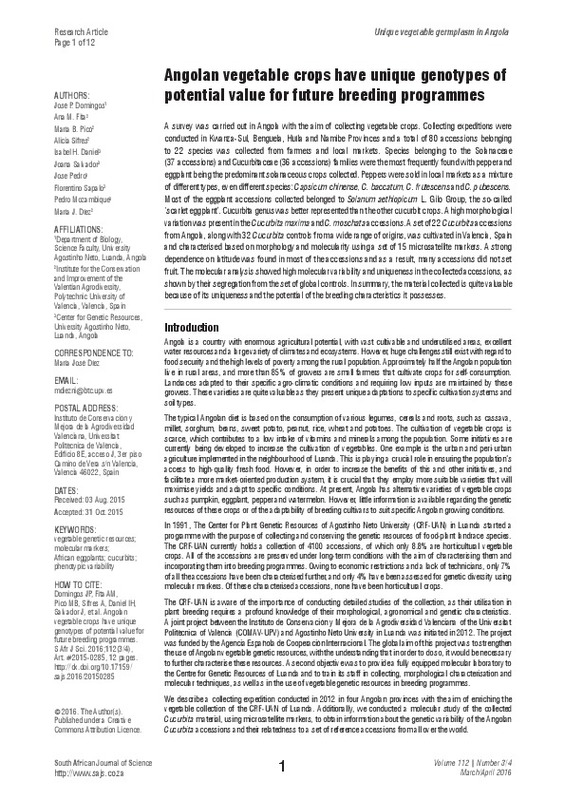JavaScript is disabled for your browser. Some features of this site may not work without it.
Buscar en RiuNet
Listar
Mi cuenta
Estadísticas
Ayuda RiuNet
Admin. UPV
Angolan vegetable crops have unique genotypes of potential value for future breeding programmes
Mostrar el registro sencillo del ítem
Ficheros en el ítem
| dc.contributor.author | Domingos, J.P.
|
es_ES |
| dc.contributor.author | Fita, Ana
|
es_ES |
| dc.contributor.author | Picó Sirvent, María Belén
|
es_ES |
| dc.contributor.author | Sifres Cuerda, Alicia Gemma
|
es_ES |
| dc.contributor.author | Daniel, Isabel H.
|
es_ES |
| dc.contributor.author | Salvador, Joana
|
es_ES |
| dc.contributor.author | PEDRO, J
|
es_ES |
| dc.contributor.author | SAPALO, F
|
es_ES |
| dc.contributor.author | MOZAMBIQUE, P
|
es_ES |
| dc.contributor.author | Díez Niclós, Mª José Teresa de Jesús
|
es_ES |
| dc.date.accessioned | 2018-02-13T08:14:46Z | |
| dc.date.available | 2018-02-13T08:14:46Z | |
| dc.date.issued | 2016 | es_ES |
| dc.identifier.issn | 0038-2353 | es_ES |
| dc.identifier.uri | http://hdl.handle.net/10251/97771 | |
| dc.description.abstract | [EN] A survey was carried out in Angola with the aim of collecting vegetable crops. Collecting expeditions were conducted in Kwanza-Sul, Benguela, Huila and Namibe Provinces and a total of 80 accessions belonging to 22 species was collected from farmers and local markets. Species belonging to the Solanaceae (37 accessions) and Cucurbitaceae (36 accessions) families were the most frequently found with pepper and eggplant being the predominant solanaceous crops collected. Peppers were sold in local markets as a mixture of different types, even different species: Capsicum chinense, C. baccatum, C. frutescens and C. pubescens. Most of the eggplant accessions collected belonged to Solanum aethiopicum L. Gilo Group, the so-called 'scarlet eggplant'. Cucurbita genus was better represented than the other cucurbit crops. A high morphological variation was present in the Cucurbita maxima and C. moschata accessions. A set of 22 Cucurbita accessions from Angola, along with 32 Cucurbita controls from a wide range of origins, was cultivated in Valencia, Spain and characterised based on morphology and molecularity using a set of 15 microsatellite markers. A strong dependence on latitude was found in most of the accessions and as a result, many accessions did not set fruit. The molecular analysis showed high molecular variability and uniqueness in the collected accessions, as shown by their segregation from the set of global controls. In summary, the material collected is quite valuable because of its uniqueness and the potential of the breeding characteristics it possesses. | es_ES |
| dc.description.sponsorship | This work, project A1/039611/11, was funded by the Agencia Espanola de Cooperacion Internacional para el Desarrollo (Spanish Agency of International Cooperation for the Development). | |
| dc.language | Inglés | es_ES |
| dc.publisher | Academy of Science of South Africa | es_ES |
| dc.relation.ispartof | South African Journal of Science | es_ES |
| dc.rights | Reconocimiento (by) | es_ES |
| dc.subject | Vegetable genetic resources | es_ES |
| dc.subject | Molecular markers | es_ES |
| dc.subject | African eggplants | es_ES |
| dc.subject | Cucurbits | es_ES |
| dc.subject | Phenotypic variability | es_ES |
| dc.subject.classification | GENETICA | es_ES |
| dc.title | Angolan vegetable crops have unique genotypes of potential value for future breeding programmes | es_ES |
| dc.type | Artículo | es_ES |
| dc.relation.projectID | info:eu-repo/grantAgreement/MAEC//A1%2F039611%2F11/ES/CREACIÓN DE INFRAESTRUCTURAS DOCENTES Y DE INVESTIGACIÓN Y FORMACIÓN DE PERSONAL UNIVERSITARIO PARA SU APROVECHAMIENTO/ | es_ES |
| dc.rights.accessRights | Abierto | es_ES |
| dc.contributor.affiliation | Universitat Politècnica de València. Departamento de Biotecnología - Departament de Biotecnologia | es_ES |
| dc.contributor.affiliation | Universitat Politècnica de València. Instituto Universitario de Conservación y Mejora de la Agrodiversidad Valenciana - Institut Universitari de Conservació i Millora de l'Agrodiversitat Valenciana | es_ES |
| dc.description.bibliographicCitation | Domingos, J.; Fita, A.; Picó Sirvent, MB.; Sifres Cuerda, AG.; Daniel, IH.; Salvador, J.; Pedro, J.... (2016). Angolan vegetable crops have unique genotypes of potential value for future breeding programmes. South African Journal of Science. 112(3):114-125. http://hdl.handle.net/10251/97771 | es_ES |
| dc.description.accrualMethod | S | es_ES |
| dc.relation.publisherversion | https://www.sajs.co.za/index | es_ES |
| dc.description.upvformatpinicio | 114 | es_ES |
| dc.description.upvformatpfin | 125 | es_ES |
| dc.type.version | info:eu-repo/semantics/publishedVersion | es_ES |
| dc.description.volume | 112 | es_ES |
| dc.description.issue | 3 | es_ES |
| dc.relation.pasarela | S\328701 | es_ES |
| dc.contributor.funder | Ministerio de Asuntos Exteriores y Cooperación | es_ES |






